Chinese Journal of Tissue Engineering Research ›› 2026, Vol. 30 ›› Issue (10): 2491-2502.doi: 10.12307/2026.611
Previous Articles Next Articles
Functional impacts of bone bruise and combined injuries in anterior cruciate ligament injuries
Zhang Shuang1, Huang Zishuai1, Wang Jian2
- 1Shandong First Medical University, Jinan 250000, Shandong Province, China; 2Department of Orthopedics, Shandong Provincial Hospital Affiliated to Shandong First Medical University, Jinan 250000, Shandong Province, China
-
Received:2025-03-10Accepted:2025-06-28Online:2026-04-08Published:2025-08-28 -
Contact:Wang Jian, MD, Chief physician, Department of Orthopedics, Shandong Provincial Hospital Affiliated to Shandong First Medical University, Jinan 250000, Shandong Province, China -
About author:Zhang Shuang, MS candidate, Physician, Shandong First Medical University, Jinan 250000, Shandong Province, China
CLC Number:
Cite this article
Zhang Shuang, Huang Zishuai, Wang Jian. Functional impacts of bone bruise and combined injuries in anterior cruciate ligament injuries[J]. Chinese Journal of Tissue Engineering Research, 2026, 30(10): 2491-2502.
share this article
Add to citation manager EndNote|Reference Manager|ProCite|BibTeX|RefWorks

2.1 前交叉韧带损伤中骨挫伤的分布模式及损伤机制分析 骨挫伤是前交叉韧带损伤后最常见的伴随损伤,其分布模式与损伤机制密切相关。骨挫伤不仅是一种影像学强度信号,而且还是损伤过程时撞击的足迹,X射线片及CT检查通常无异常改变,属于比较隐匿的骨损伤[12],MRI检查在T1加权像水肿表现为低信号,与周围正常区域脂肪的高信号形成鲜明对比;T2加权像水肿为高信号[13-14]。 骨挫伤的存在提示受伤时由于前交叉韧带功能衰竭而导致膝关节股骨和胫骨有更明显的相对位移,从而发生骨面的撞击,这不仅反映了损伤时的能量转移路径,也揭示了前交叉韧带完全撕裂以及伴随额外损伤的更高风险,因此SANDERS等[10,15-16]将膝关节骨挫伤分为5型(表1)。MORAN等[17]提出了一种新的MRI检测技术来评估骨挫伤模式,其结合了国际软骨修复学会(ICRS)的胫股关节软骨手术病变图以及全器官磁共振成像评分(WORMS)映射系统。这种新方法为标准化评估前交叉韧带损伤中的骨挫伤提供了可靠依据,有助于临床上对不同类型前交叉韧带损伤进行更精准的评估与管理。 根据损伤机制,前交叉韧带损伤分为非接触性损伤和接触性损伤,两种类型的损伤在骨挫伤的类型与位置上存在显著差异。非接触性前交叉韧带损伤常见于剧烈运动中的急停、跳跃和转向动作[18-19],无直接外力作用,占前交叉韧带损伤总数的70%-90%,研究表明,非接触性前交叉韧带损伤的主要力学机制通常涉及外旋、外翻应力[20-21]。骨挫伤多见于胫骨外侧平台和股骨外侧髁[22-23],尤其集中在股骨外侧髁的前中部以及胫骨外侧平台后部的吻合性骨挫伤,这种分布模式被称为“典型的骨挫伤模式”(图3)。这一分布特点提示,外翻应力、胫骨前移以及内旋是导致前交叉韧带损伤的主要力学机制。 (1)骨挫伤与损伤机制的联系:研究矢状面上股骨外侧髁和胫骨外侧平台骨挫伤的模式有助于进一步理解前交叉韧带损伤的力学机制[24-25],"
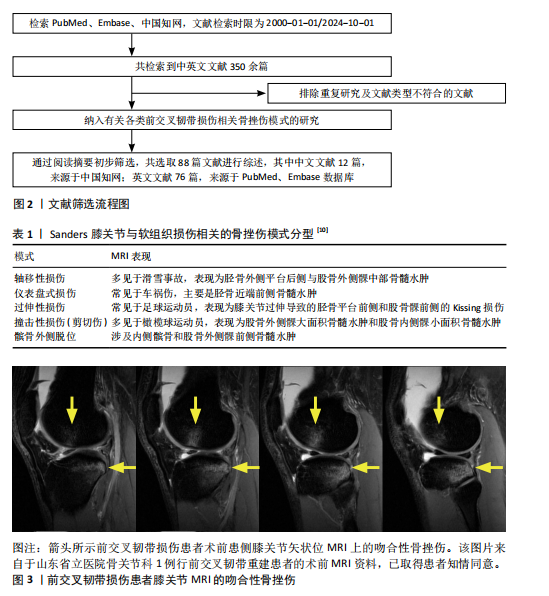
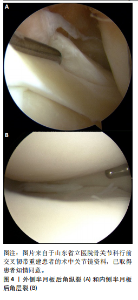
研究发现胫骨外侧平台骨挫伤多局限于后缘,这表明在骨面撞击时胫骨外侧平台后缘是固定的撞击点,而股骨外侧髁的骨挫伤则主要集中在前部或中央区域,这反映了胫骨相对于股骨的半脱位现象,即股骨外侧髁与胫骨外侧平台后缘的碰撞是主要的力学表现。此外,前交叉韧带断裂通常发生在轻度屈膝位(类似于Pivot试验的姿势)[26],在此情况下,股骨外侧髁的撞击点与膝关节的受力方向密切相关。损伤发生时,胫骨外侧平台的后缘会与股骨外侧髁的前部或中央部发生撞击,这种情况需要胫骨后缘相对于股骨发生前移。这进一步证明了胫骨的前移以及股骨髁前部撞击是非接触性前交叉韧带损伤的核心机制[23,27-28]。而股骨外侧髁与股骨内侧髁的骨挫伤分布差异进一步揭示了胫骨旋转在前交叉韧带损伤中的作用。在矢状面研究中,大多数股骨外侧髁骨挫伤局限于前部,而股骨内侧髁骨挫伤则集中在中央区域[28],这种分布差异可以通过胫骨相对于股骨的旋转运动来解释:当胫骨发生内旋时,胫骨外侧平台的后缘向前旋转,而胫骨内侧平台的后缘向后旋转,导致胫骨外侧平台后缘与股骨外侧髁的碰撞位置比胫骨内侧平台后缘与股骨内侧髁的碰撞位置更靠前,这也反映了前交叉韧带损伤时会伴随着胫骨的旋转这一结论[29]。 (2)骨挫伤的发生率与分布特点:SOHN等[30]研究表明,在非接触性前交叉韧带损伤中,胫骨外侧平台是最常受累的部位,发生率高达88.5%,其次是股骨外侧髁,发生率为81.6%。这一结果与大多数研究一致[31-32],并进一步验证了外翻应力、胫骨前移和内旋是非接触性前交叉韧带损伤最常见的机制。此外,与接触性前交叉韧带损伤相比,非接触性损伤患者更易出现内侧间室(股骨内侧髁+胫骨内侧平台)的骨挫伤[33-34]。VISKONTAS等[32]的研究发现,非接触性前交叉韧带损伤患者的胫骨内侧平台骨挫伤发生率显著高于接触性损伤患者,这表明在非接触性损伤机制中,股骨内侧髁与胫骨内侧平台之间的撞击更为频繁[35]。 (3)内侧间室骨挫伤的机制分析:关于内侧间室骨挫伤的发生机制,目前存在多种理论。研究认为,这种损伤可能与以下因素相关:初始轴移损伤期间胫骨的前移、损伤后膝关节复位时的代偿性内翻应力,以及胫骨内侧平台和股骨内侧髁间的对冲撞击[34]。 这种碰撞-对冲的损伤模式不仅涉及膝关节的力学负荷,还可能进一步导致韧带及半月板的联合损伤,从而加重膝关节的不稳定性。 骨挫伤的分布模式为非接触性前交叉韧带损伤的力学机制研究提供了重要线索。胫骨外侧平台和股骨外侧髁的吻合性骨挫伤反映了外翻应力和胫骨前移的主要作用,而内侧间室骨挫伤的发生提示了胫骨旋转及膝关节复位过程中的复杂力学变化。这些发现对于优化前交叉韧带损伤的诊断、治疗和预防策略具有重要意义。 (4)接触性前交叉韧带损伤的骨挫伤模式分析:接触性前交叉韧带损伤通常是由直接外力作用于膝关节的外侧或后方引起,如橄榄球和足球运动时的碰撞或跌倒。与非接触性损伤患者相比,接触性前交叉韧带损伤患者表现出明显不同的骨挫伤分布模式[36],这种差异主要是与外力作用的部位以及能量传递方向密切相关[35]。 在MORAN等[35]研究中,接触性前交叉韧带损伤更容易形成外侧间室骨挫伤,尤其是胫骨外侧平台(胫骨外侧平台)后方骨挫伤更明显(82.1% vs. 48.6%),而合并内侧间室骨挫伤的概率相对较低(39.7% vs. 66.2%)。在直接暴力冲击下,膝关节往往承受复杂的外翻应力及压缩应力,这表明在接触性前交叉韧带损伤时,外侧间室之间的碰撞要比内侧间室之间的碰撞更剧烈,这可能与直接暴力作用主要集中在外侧有关,也说明了当出现内侧间室骨挫伤时需要涉及明显更高的能量[37]。在接触性前交叉韧带损伤期间,直接外翻力传递了更高的能量,相对非接触性损伤来说导致外侧间室骨挫伤分布更广且靠近侧方。这种模式提示外力作用的方向和大小相对复杂,外侧间室的骨挫伤反映了外力对膝关节的直接冲击路径,提示接触性损伤往往伴随更严重的结构损伤,包括内侧副韧带、半月板以及软骨损伤。 (5)职业运动员前交叉韧带损伤模式的独特性:职业运动员的前交叉韧带损伤机制具有独特性[38-39],与其高强度竞技活动的特点密切相关。一项针对足球运动员的研究发现,股骨外侧髁中央与胫骨外侧平台的联合骨挫伤模式是非接触性前交叉韧带损伤中最典型的分布特征,发生率高达100%,占足球运动员前交叉韧带损伤病例的58%[39]。另一项对118名职业足球运动员的研究中,非接触性前交叉韧带损伤与二次前交叉韧带损伤的发生率显著增加,风险高出普通人群7倍[40]。最近一项基于视频分析的研究显示,约60%的足球运动员前交叉韧带损伤发生在脚外旋时[41]。这些研究结果揭示了职业运动员中前交叉韧带损伤的特定力学机制,骨挫伤的分布模式不仅反映了前交叉韧带损伤的力学特点,也为临床诊断和治疗提供了重要依据。 骨挫伤的分布模式为前交叉韧带损伤的机制研究和临床管理提供了重要线索。在接触性前交叉韧带损伤中,骨挫伤的外侧分布和集中特征提示膝关节受外力冲击时的路径和压力集中区域,有助于预测伴随损伤的类型和范围。而非接触性前交叉韧带损伤的分布模式则更多反映膝关节的生物力学失衡,为损伤机制的评估提供了依据。接触性和非接触性前交叉韧带损伤的骨挫伤分布差异性突出,结合影像学分析可以更准确地指导诊断、治疗和康复,以提高前交叉韧带损伤患者的预后管理水平。 2.1.2 骨挫伤的严重程度与膝关节松弛度的关系 研究发现,骨挫伤的严重程度与膝关节松弛度之间存在显著关联,膝关节松弛度不仅是反映膝关节稳定性变化的重要指标,也是评估前交叉韧带损伤严重性及其对关节功能影响的关键参数。 (1)骨挫伤与膝关节松弛度的评估:骨挫伤的严重程度通常通过MRI评估,主要表现为:骨挫伤面积或体积越大,表明关节承受的冲击能量越高;骨挫伤从表浅延伸至深部则提示更强的撞击能量作用。膝关节松弛度是指膝关节在外力作用下的异常位移或旋转幅度。 (2)骨挫伤特定分布模式与损伤严重性:骨挫伤的分布模式能够反映前交叉韧带损伤时胫骨相对于股骨的位移程度。当出现内侧间室骨挫伤往往提示为更高能量的损伤并伴随严重的膝关节松弛。吻合性骨挫伤的位置和相对距离能够反映前交叉韧带损伤时胫骨相对于股骨位移的严重程度,特别是当骨挫伤的面积越大、范围越靠后时,膝关节的不稳定性可能更为显著[42]。此外,伴有广泛骨挫伤的膝关节,其松弛度增加通常与联合损伤(如半月板或副韧带损伤)发生率显著升高有关。这种现象表明,骨挫伤不仅是膝关节不稳定的表现之一,还可能反映联合损伤的潜在风险。骨挫伤与膝关节松弛度成为损伤后重要的临床考量。 (3)研究与发现:关于骨挫伤与膝关节松弛度的关系,不同研究虽然在数据和具体结论上有所差异[43-44],但大部分研究指出骨挫伤是评估前交叉韧带损伤后膝关节稳定性的重要指标。骨挫伤的严重程度通常反映了膝关节在损伤时的力学负荷,其与膝关节的松弛度和功能障碍密切相关。LI等[42]通过对205例急性非接触性前交叉韧带损伤患者的回顾性分析研究表明,吻合性骨挫伤的存在与膝关节的前后向及旋转不稳定性显著相关;特别是当股骨外侧髁上骨挫伤位置向前移动时,与膝关节的前后不稳定性关系更为密切。此外,SONG等[45]和AGOSTINONE等[44]研究揭示了急性前交叉韧带损伤中骨挫伤特定模式与膝关节旋转松弛度之间的关系,术中评估前交叉韧带缺陷的膝关节时,严重的双间室骨挫伤(包括内侧和外侧)与更高的旋转不稳定性相关,而胫骨内侧平台骨挫伤的严重程度与术中枢轴移位程度直接相关,这为前交叉韧带损伤后关节不稳定的评估提供了新的视角,揭示了不同损伤机制对膝关节稳定性产生的不同影响。在临床实践中,骨挫伤的分布模式和严重程度可作为评估膝关节松弛度的重要工具,帮助识别潜在的不稳定性和联合损伤风险。对于伴随严重骨挫伤的患者,需特别关注膝关节的前后向及旋转松弛度,在术后康复中针对性制定治疗方案。这一发现提示,在早期诊断和治疗过程中,应重视骨挫伤的评估,以减少术后功能障碍的发生。 2.1.3 骨挫伤的动态变化与影像学评估 骨挫伤并非静态病变,其形态和分布会随时间而变化。在急性期和恢复期,骨挫伤的影像学表现存在显著差异。急性期的骨挫伤主要表现为水肿和出血的信号特征,随着时间的推移,这些特征逐渐被骨髓硬化和修复信号所替代,提示骨挫伤具有一定的自我修复能力。因此,在前交叉韧带损伤的随访中,应通过多次MRI检查对骨挫伤进行动态评估,以准确判断其恢复情况。 急性期与亚急性期的骨挫伤:研究表明,急性期(损伤时间≤6周)和亚急性期(6周< 损伤时间≤13周)是骨挫伤表现最为显著的阶段,此时的发生率超过80%。但进入中期(13周< 损伤时间≤1年)后,骨挫伤的发生率显著下降,仅约为57%[46],这表明骨挫伤随时间推移会逐渐消退,尤其是在组织修复过程开始后,水肿和出血被纤维组织和骨硬化信号取代。骨挫伤研究中一个重要的局限性在于无法控制从损伤到MRI成像的时间,而MRI检查的时间是影响骨挫伤模式可靠性的主要因素。PATEL等[22] 回顾了前交叉韧带损伤后MRI采集的时间,发现各研究中采集时间跨度较大,从6 d到9周不等。尽管不同时间的MRI检查均可提供骨挫伤的影像学信息,但早期检查通常更能捕捉到急性骨挫伤的特征。有研究则进一步指出,大多数骨挫伤在受伤后约6周便开始消退。因此,为了准确将骨挫伤模式与前交叉韧带损伤机制相联系,受伤后30 d内的MRI检查被认为是研究骨挫伤模式的最佳时间窗口。这一标准不仅有助于捕捉骨挫伤的急性期特征,也能最大程度地避免因骨挫伤的自然修复而导致的影像学信号变化,从而提高研究的可靠性和临床相关性。 骨挫伤的动态变化为临床评估前交叉韧带损伤后的恢复状况提供了重要信息。由于骨挫伤具有一定的自愈能力,其形态和范围在随时间推移中可能发生显著变化。早期的骨挫伤多伴随显著的水肿和骨髓信号异常,表明损伤区域的高能量冲击;而后期的骨髓硬化信号则说明正处于修复时期。因此,在前交叉韧带损伤的随访中,通过多次MRI影像检查动态观察骨挫伤的变化,有助于全面评估患者的损伤恢复情况。 2.2 前交叉韧带损伤中的联合损伤 前交叉韧带损伤时通常会伴随膝关节其他结构的联合损伤,其中半月板、软骨损伤以及内侧副韧带的损伤最为常见。这些联合损伤不仅显著影响膝关节的稳定性,还可能对治疗策略和患者的预后产生深远影响,并增加手术难度[33]。因此,在前交叉韧带损伤的诊断和治疗过程中,全面评估联合损伤的范围和严重程度对于制定个性化治疗方案至关重要。 2.2.1 半月板损伤的特点及其与骨挫伤的关联 半月板是膝关节中重要的缓冲结构,主要功能是吸收应力、分散负荷和维持关节稳定性。在半月板损伤中(图4),外侧半月板损伤最为常见,发生率为15%-73%,其次是内侧半月板损伤,发生率为10%- 55%[47]。SOHN等[30]研究报道了39.6%的患者出现内侧半月板损伤,43.8%的患者出现外侧半月板损伤,这与大部分研究一致。值得注意的是,大多数半月板损伤发生在半月板后角,这是因为内侧半月板和外侧半月板的后角分别为胫骨前移和胫骨内旋提供了二级稳定性[48]。有研究发现半月板损伤与胫骨挫伤而非股骨挫伤相关的原因可能是冠状韧带的存在,冠状韧带连接胫骨和半月板,在胫骨侧的附着点更牢固。因此,当胫骨受到撞击时,"
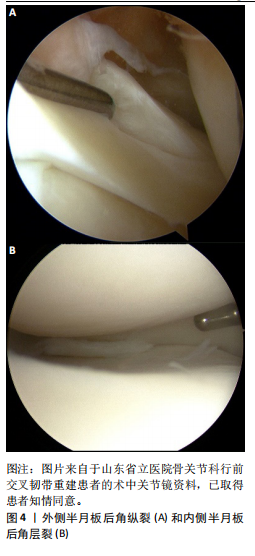
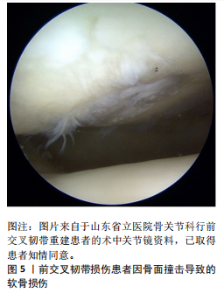
冠状韧带会将撞击力直接传递到半月板上,从而导致半月板的纤维损伤。这一机制进一步解释了胫骨挫伤与半月板损伤之间的密切联系。 (1)骨挫伤与半月板损伤的关系:关于前交叉韧带损伤中骨挫伤与半月板损伤的关系,不同研究结果存在一定争议。一些研究支持两者之间存在显著关联,尤其是在外侧间室(胫骨外侧平台+股骨外侧髁)骨挫伤与外侧半月板损伤的关系中。YOON等[49]观察到在伴有广泛外侧间室骨挫伤的患者中,外侧半月板病变的发生率显著升高,这可能是因为外侧间室骨挫伤反映了前交叉韧带损伤时外侧半月板受到股骨与胫骨挤压的应力集中,导致撕裂风险增加。BISSON等[50]的研究进一步证实了外侧间室骨挫伤与外侧半月板撕裂的相关性,并指出胫骨外侧平台骨挫伤的严重程度增加与内侧半月板撕裂有关。孟凡华等[33]发现单纯外侧间室骨挫伤者和联合间室骨挫伤者均较无骨挫伤者更易伴发外侧半月板损伤。 近来,CALVO-GURRY等[51]研究表明,胫骨内侧平台的骨挫伤与内侧半月板后角撕裂有关;KIM等[52]和SONG等[45]使用ICRS分级来衡量骨挫伤的严重程度,研究发现胫骨外侧平台骨挫伤的严重程度与外侧半月板撕裂有关,胫骨内侧平台处骨挫伤的严重程度与内侧半月板撕裂有关;BISSON等[50]的研究也指出胫骨外侧平台骨挫伤的严重程度与内侧半月板撕裂的相关性;SONG等[45]研究表明股骨外侧髁骨挫伤的严重程度与外侧半月板撕裂有相关性,但与内侧半月板撕裂和软骨损伤无相关性。这提示骨挫伤的分布与半月板损伤的类型存在一定关联。 然而,也有研究对骨挫伤与半月板损伤之间的关联提出质疑。BASTOS等[53]认为骨挫伤不应被视为半月板撕裂严重程度的指标或用来推断损伤的严重性。BORDONI等[54]和NOVARETTI等[55]的研究中未发现骨挫伤与任何半月板病变之间存在显著关系。因此,骨挫伤与半月板损伤之间的关系仍存在争议,为了更全面地揭示其潜在关联,有必要进一步回顾更多研究结果,并结合更严格的研究设计和一致的影像学评估标准,为临床诊断和治疗提供更加明确的依据。 (2)骨挫伤与外侧半月板损伤的定量分析:尽管存在争议,但部分研究通过定量分析发现骨挫伤与外侧半月板损伤之间存在显著关联。在综述的6项研究中[30],共分析了651例有骨挫伤的患者,46.7%(304/651)的骨挫伤患者存在外侧半月板损伤,而没有骨挫伤的患者为24.5%(50/204)。统计分析显示,有骨挫伤的个体发生外侧半月板损伤的可能性是无骨挫伤个体的2.71倍,这表明骨挫伤与外侧半月板损伤之间存在显著相关性。 (3)骨挫伤与内侧半月板损伤的定量分析:对于骨挫伤与内侧半月板损伤的关系,结果则显得不尽一致。在相同的6项研究中,有骨挫伤的患者中36.6%(238/651)伴发内侧半月板损伤,而无骨挫伤的患者中这一比例为39.7%(81/204)。这一结果表明,骨挫伤的存在并未显著增加内侧半月板损伤的风险。 目前关于骨挫伤与半月板损伤之间的关系仍存在一定争议,但研究总体趋势表明,骨挫伤与外侧半月板损伤之间具有显著相关性,尤其是当骨挫伤集中于胫骨外侧平台或股骨外侧髁时。然而,骨挫伤与内侧半月板损伤之间的关联性较弱,现有数据未能证实骨挫伤增加内侧半月板损伤风险的显著性差异。因此,有必要进一步的大规模、多中心研究明确骨挫伤与半月板损伤关系,这将有助于优化前交叉韧带损伤患者的诊断和治疗策略。 (4)Ramp损伤及损伤机制:Ramp损伤是前交叉韧带损伤中涉及内侧半月板后角的特殊类型损伤,发生率在9%-42%[56-57],通常定义为发生在内侧半月板后角、半月板囊韧带、半月板胫骨韧带交界范围内的纵向垂直撕裂[56],损伤后更容易导致膝关节的旋转不稳定和功能障碍[58]。然而,由于Ramp损伤的特殊解剖位置,术前影像检查和常规前路关节镜检查常有漏诊风险[59]。尽管MRI在检测Ramp损伤中表现出较高的特异性(高达98.11%),但其敏感度相对较低,某些研究报道的敏感度仅为45%[60-62]。 这种较低的敏感性可能导致部分Ramp损伤在术前未被发现,使得关节镜检查成为补充诊断的重要手段。然而,由于Ramp损伤位于内侧半月板后角的隐匿区域,传统前路或前外侧入路的关节镜检查容易漏诊。因此,临床上应结合影像学和改良入路的关节镜技术(如后内侧入路),以提高Ramp损伤的检出率。Ramp损伤的发生通常与前交叉韧带损伤时胫骨前移导致的挤压性损伤相关。研究表明,股骨内侧髁骨挫伤、胫骨前移被看作为 Ramp损伤的危险因素。胫骨前移使内侧半月板后角与关节囊连接处受到挤压和拉伸,应力集中在内侧后角区域,从而导致半月板和相关韧带的损伤[58,63-66]。而半膜肌的代偿性收缩可能导致内侧后方的压力增加和随后的半月板韧带损伤。上述机制揭示了Ramp损伤的发生与膝关节复杂的力学变化之间的紧密联系,为其早期诊断和治疗提供了理论依据。 (5)Ramp损伤与胫骨后内侧平台骨挫伤的关联:研究表明,Ramp损伤与胫骨后内侧平台骨挫伤显著相关,是提示Ramp损伤的重要影像学征象。DEPHILLIPO等[60]报道,72%的Ramp损伤患者在胫骨后内侧平台发现骨挫伤。BALAZS等[57]和CALVO-GURRY 等[51]也证实了这种关联。BEEL等[63]报道患者出现胫骨后内侧平台骨挫伤时,发生Ramp损伤的风险是无骨挫伤患者的6倍。此外,一项研究显示,在术前MRI观察到胫骨后内侧平台骨挫伤的患者中,通过关节镜确认Ramp损伤的概率增加了2.05倍[64]。这些发现强调了胫骨后内侧平台骨挫伤作为Ramp损伤风险标志的重要性。 (6) Ramp损伤治疗策略与临床意义:Ramp损伤是选择治疗方案的重要考量因素。未处理的Ramp损伤可能导致术后膝关节不稳定、再损伤或功能恢复欠佳[67-68],从而影响患者的生活质量和长期预后。针对稳定性较差的Ramp损伤,通常建议在关节镜下进行缝合修复,以恢复内侧半月板的完整性和功能。此外,Ramp损伤的修复有助于减少术后膝关节旋转不稳的风险,并提高前交叉韧带重建手术的成功率。 半月板损伤的存在不仅增加了膝关节的不稳定性,还可能导致术后恢复不良和长期功能障碍。因此,在前交叉韧带重建手术中,半月板的处理策略至关重要,尤其是对于Ramp损伤的患者,应考虑进行半月板修复或部分切除,以提高术后膝关节的稳定性和功能恢复。 2.2.2 骨挫伤与软骨损伤的相关性 骨挫伤的存在通常与其相应区域的软骨层损伤密切相关[69],软骨损伤发生于10.7%-32.9%的前交叉韧带损伤病例中[30](图5)。多项研究发现,与没有骨挫伤的患者相比,内侧或外侧间室骨挫伤的患者更容易伴发软骨"
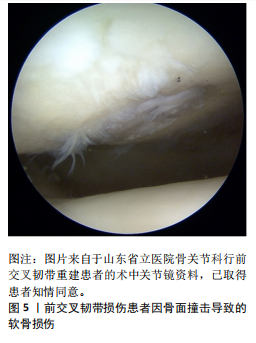

损伤[42,54,70]。SOHN等[30]研究发现19.9%(75/376)的骨挫伤患者同时存在软骨损伤,而无骨挫伤组的这一比例为2.7%(2/75);进一步分析证实,有骨挫伤的患者发生软骨损伤的可能性是无骨挫伤患者的6.18倍,这表明在伴有骨挫伤的前交叉韧带损伤中,由更大的创伤力量导致的骨挫伤继而使软骨损伤的可能性增加。因此,在前交叉韧带损伤的评估中,特别是在骨挫伤区域,应警惕潜在的软骨损伤,以便制定更全面的治疗策略,改善患者的长期预后。 (1)骨挫伤面积与软骨损伤严重程度:骨挫伤的严重程度(如面积和体积)与软骨损伤的严重程度也存在显著相关性。KIA等[15]通过回顾性分析40例前交叉韧带损伤患者MRI资料,测量术前骨挫伤面积并记录软骨损伤分度,发现骨挫伤面积越大,软骨损伤的严重程度越高。FILARDO等[71]在系统性综述中分析了13项研究,有11项研究证实了骨挫伤严重程度与软骨损伤之间的显著关联。这些研究结果进一步强调了两者之间的病理关联性,并提示在前交叉韧带损伤的评估中,应重点关注骨挫伤的严重程度以预测软骨损伤的风险。 (2)软骨损伤儿童与成人的差异:在儿科患者中,骨挫伤与软骨损伤之间的关系可能有所不同,BORDONI等[54]分析了儿科前交叉韧带损伤患者骨挫伤与软骨损伤的关系,这种相关性在儿科人群中并不成立。在伴有骨挫伤的年轻患者中,只有3.7%的患者存在软骨损伤。发生率较低可能是儿童前交叉韧带损伤通常由较低能量的运动损伤引起,从而减少了软骨损伤的风险。此外,有研究认为年轻人的关节组织对创伤性损伤更具有弹性和恢复力,且软骨厚度受性别、体质量和体力活动的影响较大,通常比成人更厚[72]。这些因素可能共同降低了儿童软骨损伤的风险。因此,有必要在未来的研究中通过区分儿童和成人来明确研究骨挫伤和软骨损伤之间的关系,为不同年龄段前交叉韧带损伤患者的评估和治疗提供更有针对性的依据。 2.2.3 内侧副韧带损伤及骨挫伤的相关性 前交叉韧带撕裂很少单独发生,误诊或未治疗的相关外周松弛是前交叉韧带移植物失败的最常见原因之一,因此必须认识和治疗伴随的侧副韧带损伤。内侧副韧带损伤在前交叉韧带撕裂患者中是最常见的。MRI研究报告显示,内侧副韧带损伤的患病率在22%-67%之间[73-74],这种差异可能是由于从损伤到MRI的时间间隔不同,以及用于定义内侧副韧带复杂结构(浅层内侧副韧带、深层内侧副韧带和后斜韧带)损伤的评估和标准的差异。相比之下,外侧副韧带的损伤相对较少,发生率仅为2.4%,这主要与损伤机制(如内翻负荷)不同有关。 (1)内侧副韧带损伤与骨挫伤的力学机制:内侧副韧带损伤时,骨挫伤通常发生在胫骨内侧平台和股骨内侧髁的附着部位附近。内侧副韧带损伤的主要机制为外翻应力。当膝关节承受外翻暴力时,内侧副韧带的附着点与胫骨和股骨内侧区域承受的应力显著增加,导致骨挫伤的发生。在外翻和外旋应力的联合作用下,深层内侧副韧带首先受损,随后胫骨的外旋失控进一步加剧了内侧骨挫伤的严重程度。 (2)研究与发现:DEPHILIPPO等[60]研究表明,胫骨内侧平台的骨挫伤是内侧副韧带损伤的显著指征,严重的胫骨内侧平台骨挫伤常提示深层内侧副韧带的纤维断裂。KIA等[15]研究指出,在前交叉韧带+内侧副韧带联合损伤的患者中,骨挫伤的分布常以内侧间室为主,而单纯前交叉韧带损伤患者更多出现外侧间室骨挫伤。CRISTIANI等[73]的研究显示,股骨内侧髁骨挫伤和股骨外侧髁切迹征与孤立性深层内侧副韧带损伤存在显著相关性。此外,研究还发现,外侧半月板损伤和股骨外侧髁骨挫伤显著增加了内侧副韧带损伤的发生概率,而内侧半月板损伤的发生率在内侧副韧带损伤患者中反而降低。急性情况下,内侧半月板损伤通常由内翻和内旋应力引起[75],这与内侧副韧带损伤的外翻和外旋机制正好相反。因此,内侧副韧带损伤患者中内侧半月板损伤的发生率(42.9%)显著低于无内侧副韧带损伤患者(66.2%)。这一现象进一步支持了两种损伤机制的互斥性。 在部分或完全浅层内侧副韧带损伤的情况下,深层内侧副韧带总是有损伤。研究显示,与浅层内侧副韧带相比,深层内侧副韧带具有显著更低的失效载荷(101 N vs. 557 N)[76],这表明在外翻和外旋联合作用期间,深层内侧副韧带损伤通常先于浅层内侧副韧带损伤发生。由于深层内侧副韧带损伤引起的胫骨外旋增加,浅层内侧副韧带和前交叉韧带随后受到影响,表明深层内侧副韧带在膝关节稳定中起关键作用,其损伤是前内侧旋转不稳定的重要病理基础[73]。ALM等[77]报道,当内侧膝关节松弛时,前交叉韧带重建翻修失败的风险增加17倍。骨挫伤的存在应作为内侧副韧带损伤的重要提示标志。未能充分识别或修复的内侧副韧带损伤可能导致前交叉韧带重建术后的膝关节不稳,增加术后康复的难度。这一发现强调了在前交叉韧带和内侧副韧带联合损伤病例中,全面评估和处理内侧副韧带损伤的重要性,以改善患者的术后预后。 半月板损伤、软骨损伤和内侧副韧带损伤的术中识别和修复对前交叉韧带重建术的成功与否具有重要影响。未识别的伴随损伤可能导致术后膝关节不稳,因此,术前MRI的全面评估和术中修复对确保术后关节稳定性、提升患者的术后生活质量具有重要意义。联合损伤的复杂性给临床实践带来了挑战。 2.3 骨挫伤对前交叉韧带重建术后功能的影响 2.3.1 骨挫伤与术后功能恢复的关系 骨挫伤对术后功能恢复和生活质量的影响一直存在争议。有研究认为骨挫伤部位的软骨下骨在骨折愈合后形成骨痂,使局部顺应性降低,局部关节软骨吸收的应力增加,最终导致关节软骨慢性退变[71]。此外,骨挫伤的严重程度被认为与膝关节功能恢复时间密切相关[78],而且肌力表现可能会因为骨挫伤或早期软骨磨损而导致的疼痛和功能障碍进一步恶化[79]。严重的骨挫伤患者术后康复时间明显延长,且膝关节的活动度和稳定性较差[80],这可能是由于骨面撞击后导致更为严重的骨髓水肿和软骨损伤,进而影响关节结构的恢复能力。GAGE等[81]发现,股骨外侧髁处骨挫伤是术前实现膝关节完全伸展时间延迟的预测因素。SZKOPEK等[82]研究表明,胫骨内侧平台和股骨外侧髁骨挫伤部位的疼痛与骨挫伤的严重程度显著相关,并影响早期康复中的活动范围。因此,在前交叉韧带重建术后的康复过程中,应特别注意骨挫伤的恢复情况,合理安排康复计划以促进膝关节功能的早期恢复。 对于骨挫伤范围较大的患者,早期康复过程中需严格控制负重和活动强度,以降低术后复发风险。DELLA VILLA等[83]提出,对于合并骨挫伤的急性前交叉韧带断裂的患者,损伤早期应限制性负重,避免轴向应力进一步损伤骨挫伤部位的关节软骨和软骨下骨。个性化的康复策略,如动态平衡训练和功能性动作训练,有助于提高术后康复效果。 不同研究对骨挫伤与功能和临床评分之间的关系结论不一。SZKOPEK等[82]发现,骨挫伤的严重程度与术后膝关节功能评分(如KOOS评分)之间存在显著关联,骨挫伤患者的疼痛评分更高,功能恢复更差。DRIBAN等[84]还发现,骨挫伤体积增加与KOOS评分较低有关;但PANJWANI等[85]发现,骨挫伤的存在并未显著影响KOOS评分及SF-36疼痛分量表评分。GALLOWAY等[86]和KIM等[52]的研究结果与PANJWANI等[85]一致,均未发现骨挫伤与功能评分之间存在明确关联。研究结果之所以存在差异,可能是因为SZKOPEK等[82]是根据骨挫伤的严重程度来描述其研究结果的,而GALLOWAY等[86]、KIM等[52]和PANJWANI等[85]是根据骨挫伤的存在来描述其研究结果的,而且不同研究对功能评估时间点的选择存在差异。总体来看,骨挫伤严重程度的增加和联合损伤的存在可能显著降低功能评分,延缓康复进程,影响患者的长期预后。 2.3.2 骨挫伤与其他术后并发症的关系 研究表明,广泛的骨挫伤分布和更为严重的骨挫伤通常提示术后恢复较差[44],特别是伴随半月板损伤及软骨损伤时,易出现早期并发症,如膝关节不稳定、主观膝关节预后较差和膝关节炎[87-88]。KIA等[15]发现,受伤时初始骨挫伤面积与创伤后软骨病变进展之间存在显著关系,而软骨损伤后进一步发展为骨关节炎。有报道称胫骨外侧平台后缘的骨挫伤与术后旋转不稳定性密切相关,而股骨内侧髁的骨挫伤则可能导致膝关节活动度受限[44]。DRIBAN等[84]的研究表明,骨挫伤体积与疼痛程度呈正相关,体积越大,术后疼痛风险越高。可能是因为骨挫伤常伴有软骨下骨的微小骨折和血供障碍,而这些病变可能在术后引发骨愈合不良和局部炎症反应。 为了降低术后并发症风险,应加强术前MRI评估骨挫伤的严重程度和分布模式。对严重骨挫伤患者,需在术后康复过程中严格控制负重和活动强度,并及时评估关节稳定性。通过早期干预(如保护性负重、针对性物理治疗和疼痛管理),可减少术后慢性疼痛的发生,并优化总体疗效。同时半月板损伤、软骨损伤会加速膝关节的退变进程,增加关节炎的发生风险。因此,在临床实践中,应重点评估前交叉韧带损伤患者的联合损伤情况,以优化治疗决策,降低术后并发症的风险。 骨挫伤特征及伴随损伤相关性总结,见表2。"
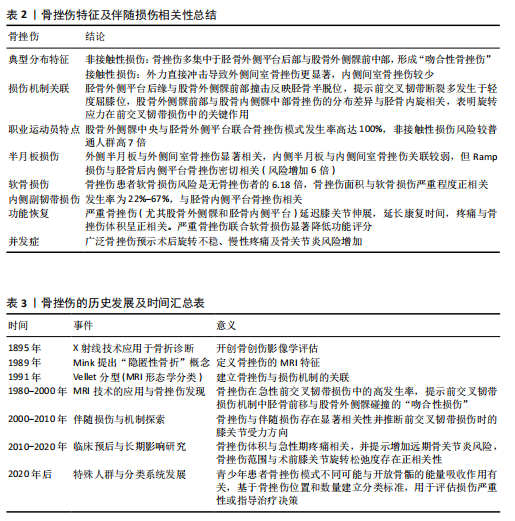
| [1] KAEDING CC, LÉGER-ST-JEAN B, MAGNUSSEN RA. Epidemiology and Diagnosis of Anterior Cruciate Ligament Injuries. Clin Sports Med. 2017;36(1):1-8. [2] BAE BS, YOO S, LEE SH. Ramp lesion in anterior cruciate ligament injury: a review of the anatomy, biomechanics, epidemiology, and diagnosis. Knee Surg Relat Res. 2023; 35(1):23. [3] CHUNG KS, KIM JH, KONG DH, et al. An Increasing Trend in the Number of Anterior Cruciate Ligament Reconstruction in Korea: A Nationwide Epidemiologic Study. Clin Orthop Surg. 2022;14(2):220-226. [4] HELITO CP, DA SILVA AGM, GUIMARÃES TM, et al. Functional results of multiple revision anterior cruciate ligament with anterolateral tibial tunnel associated with anterolateral ligament reconstruction. Knee Surg Relat Res. 2022;34(1):24. [5] SANDERS TL, MARADIT KREMERS H, BRYAN AJ, et al. Incidence of Anterior Cruciate Ligament Tears and Reconstruction: A 21-Year Population-Based Study. Am J Sports Med. 2016;44(6):1502-1507. [6] 张敏.2D与3DMR快速自旋回波序列对膝关节交叉韧带及半月板损伤的诊断价值比较[J].现代医用影像学,2020,29(5): 905-906. [7] 常丽鹏,赵敏,龚国龄,等.MRI在膝关节半月板损伤、前交叉韧带损伤诊断中的应用价值研究[J].中国CT和MRI杂志, 2020,18(8):164-167. [8] MOHANKUMAR R, WHITE LM, NARAGHI A. Pitfalls and pearls in MRI of the knee. AJR Am J Roentgenol. 2014;203(3):516-530. [9] 朱明磊.探讨分析用3.0T核磁共振技术诊断膝关节损伤的临床效果[J].影像研究与医学应用,2021,5(2):148-149,151. [10] SANDERS TG, MEDYNSKI MA, FELLER JF, et al. Bone contusion patterns of the knee at MR imaging: footprint of the mechanism of injury. Radiographics. 2000;20 Spec No: S135-151. [11] 潘敏.MRI检查前交叉韧带损伤的诊断价值及影像学特征分析[J].影像研究与医学应用,2024,8(1):148-150. [12] DAI R, WU Y, JIANG Y, et al. Comparison of Bone Bruise Pattern Epidemiology between Anterior Cruciate Ligament Rupture and Patellar Dislocation Patients-Implications of Injury Mechanism. Bioengineering (Basel). 2023;10(12):1366. [13] LI X, MA BC, BOLBOS RI, et al. Quantitative assessment of bone marrow edema-like lesion and overlying cartilage in knees with osteoarthritis and anterior cruciate ligament tear using MR imaging and spectroscopic imaging at 3 Tesla. J Magn Reson Imaging. 2008;28(2):453-461. [14] 关清,汤光宇,华婷,等.前交叉韧带急性和慢性损伤的核磁共振诊断价值比较研究[J].同济大学学报(医学版),2019, 40(1):82-86. [15] KIA C, CAVANAUGH Z, GILLIS E, et al. Size of Initial Bone Bruise Predicts Future Lateral Chondral Degeneration in ACL Injuries: A Radiographic Analysis. Orthop J Sports Med. 2020;8(5):2325967120916834. [16] 刘超,尹科,阳志军,等.急性前交叉韧带损伤中骨挫伤磁共振成像特征及意义[J].中国运动医学杂志,2023,42(7):540-546. [17] MORAN J, KATZ LD, SCHNEBLE CA, et al. A Novel MRI Mapping Technique for Evaluating Bone Bruising Patterns Associated With Noncontact ACL Ruptures. Orthop J Sports Med. 2022;10(4): 23259671221088936. [18] OWUSU-AKYAW KA, KIM SY, SPRITZER CE, et al. Determination of the Position of the Knee at the Time of an Anterior Cruciate Ligament Rupture for Male Versus Female Patients by an Analysis of Bone Bruises. Am J Sports Med. 2018;46(7):1559-1565. [19] QIU L, SHENG B, LI J, et al. Mechanisms of non-contact anterior cruciate ligament injury as determined by bone contusion location and severity. Quant Imaging Med Surg. 2021;11(7):3263-3273. [20] SHI H, DING L, REN S, et al. Prediction of Knee Kinematics at the Time of Noncontact Anterior Cruciate Ligament Injuries Based on the Bone Bruises. Ann Biomed Eng. 2021;49(1):162-170. [21] MIHATA LC, BEUTLER AI, BODEN BP. Comparing the incidence of anterior cruciate ligament injury in collegiate lacrosse, soccer, and basketball players: implications for anterior cruciate ligament mechanism and prevention. Am J Sports Med. 2006;34(6):899-904. [22] PATEL SA, HAGEMAN J, QUATMAN CE, et al. Prevalence and location of bone bruises associated with anterior cruciate ligament injury and implications for mechanism of injury: a systematic review. Sports Med. 2014;44(2):281-293. [23] ZHANG L, HACKE JD, GARRETT WE, et al. Bone Bruises Associated with Anterior Cruciate Ligament Injury as Indicators of Injury Mechanism: A Systematic Review. Sports Med. 2019;49(3):453-462. [24] 傅德杰,郭林,杨柳.对吻性骨挫伤在急性前交叉韧带断裂中的临床特征研究[J].中华骨与关节外科杂志,2020,13(12): 1007-1011. [25] 李明,刘宁.急性前十字韧带撕裂位置对骨挫伤面积的影响[J].中华骨科杂志, 2021,41(2):103-108. [26] KIM SY, SPRITZER CE, UTTURKAR GM, et al. Knee Kinematics During Noncontact Anterior Cruciate Ligament Injury as Determined From Bone Bruise Location. Am J Sports Med. 2015;43(10):2515-2521. [27] LATTERMANN C, JACOBS CA, REINKE EK, et al. Are Bone Bruise Characteristics and Articular Cartilage Pathology Associated with Inferior Outcomes 2 and 6 Years After Anterior Cruciate Ligament Reconstruction? Cartilage. 2017;8(2):139-145. [28] KIM-WANG SY, SPRITZER CE, OWUSU-AKYAW K, et al. The Predicted Position of the Knee Near the Time of ACL Rupture Is Similar Between 2 Commonly Observed Patterns of Bone Bruising on MRI. Am J Sports Med. 2023;51(1):58-65. [29] LEVINE JW, KIAPOUR AM, QUATMAN CE, et al. Clinically relevant injury patterns after an anterior cruciate ligament injury provide insight into injury mechanisms. Am J Sports Med. 2013;41(2):385-395. [30] SOHN S, ALSHAMMARI SM, LEE JH, et al. Bone Bruises and Concomitant Meniscus and Cartilage Damage in Anterior Cruciate Ligament Injuries: A Systematic Review and Meta-Analysis. Bioengineering (Basel). 2024;11(5):515. [31] ILLINGWORTH KD, HENSLER D, CASAGRANDA B, et al. Relationship between bone bruise volume and the presence of meniscal tears in acute anterior cruciate ligament rupture. Knee Surg Sports Traumatol Arthrosc. 2014;22(9):2181-2186. [32] VISKONTAS DG, GIUFFRE BM, DUGGAL N, et al. Bone bruises associated with ACL rupture: correlation with injury mechanism. Am J Sports Med. 2008;36(5):927-933. [33] 孟凡华,林祥明,林丽萍,等.非接触性急性前交叉韧带撕裂骨挫伤分布特点及与其他关节伴随损伤的相关性分析[J].中国医学计算机成像杂志,2021,27(6):546-551. [34] BYRD JM, COLAK C, YALCIN S, et al. Posteromedial Tibial Bone Bruise After Anterior Cruciate Ligament Injury: An MRI Study of Bone Bruise Patterns in 208 Patients. Orthop J Sports Med. 2022; 10(10):23259671221120636. [35] MORAN J, LEE MS, KUNZE KN, et al. Examining the Distribution of Bone Bruise Patterns in Contact and Noncontact Acute Anterior Cruciate Ligament Injuries. Am J Sports Med. 2023;51(5):1155-1161. [36] UBL ST, VIEIDER RP, SEILERN UND ASPANG J, et al. Bone bruise distribution predicts anterior cruciate ligament tear location in non-contact injuries. J Exp Orthop. 2024; 11(3):e12034. [37] 张乐刚,李斌,项帅,等.基于MRI评估非接触性ACL损伤的骨挫伤模式[J].临床医学进展,2024,14(2):3858-3865. [38] BROPHY RH, BAKER JC, CRAIN JM, et al. MRI Findings Associated With Anterior Cruciate Ligament Tears in National Football League Athletes. Orthop J Sports Med. 2023;11(6):23259671231169190. [39] D’HOOGHE P, GRASSI A, VILLA FD, et al. The injury mechanism correlation between MRI and video-analysis in professional football players with an acute ACL knee injury reveals consistent bone bruise patterns. Knee Surg Sports Traumatol Arthrosc. 2023; 31(1):121-132. [40] DELLA VILLA F, HÄGGLUND M, DELLA VILLA S, et al. High rate of second ACL injury following ACL reconstruction in male professional footballers: an updated longitudinal analysis from 118 players in the UEFA Elite Club Injury Study. Br J Sports Med. 2021;55(23):1350-1356. [41] DELLA VILLA F, BUCKTHORPE M, GRASSI A, et al. Systematic video analysis of ACL injuries in professional male football (soccer): injury mechanisms, situational patterns and biomechanics study on 134 consecutive cases. Br J Sports Med. 2020; 54(23):1423-1432. [42] LI J, MAO Y, WANG D, et al. Correlation Between the Location and Distance of Kissing Contusions and Knee Laxity in Acute Noncontact ACL Injury. Am J Sports Med. 2023;51(12):3179-3189. [43] MAROT V, CORIN B, REINA N, et al. Femoral and tibial bone bruise volume is not correlated with ALL injury or rotational instability in patients with ACL-deficient knee. Knee Surg Sports Traumatol Arthrosc. 2021;29(3):900-906. [44] AGOSTINONE P, DI PAOLO S, LUCIDI GA, et al. Severe bicompartmental bone bruise is associated with rotatory instability in anterior cruciate ligament injury. Knee Surg Sports Traumatol Arthrosc. 2022;30(5): 1725-1732. [45] SONG GY, ZHANG H, WANG QQ, et al. Bone Contusions After Acute Noncontact Anterior Cruciate Ligament Injury Are Associated With Knee Joint Laxity, Concomitant Meniscal Lesions, and Anterolateral Ligament Abnormality. Arthroscopy. 2016; 32(11):2331-2341. [46] THEOLOGIS AA, KUO D, CHENG J, et al. Evaluation of bone bruises and associated cartilage in anterior cruciate ligament-injured and -reconstructed knees using quantitative t(1ρ) magnetic resonance imaging: 1-year cohort study. Arthroscopy. 2011;27(1):65-76. [47] HAGINO T, OCHIAI S, SENGA S, et al. Meniscal tears associated with anterior cruciate ligament injury. Arch Orthop Trauma Surg. 2015;135(12):1701-1706. [48] MUSAHL V, CITAK M, O’LOUGHLIN PF, et al. The effect of medial versus lateral meniscectomy on the stability of the anterior cruciate ligament-deficient knee. Am J Sports Med. 2010;38(8):1591-1597. [49] YOON KH, YOO JH, KIM KI. Bone contusion and associated meniscal and medial collateral ligament injury in patients with anterior cruciate ligament rupture. J Bone Joint Surg Am. 2011;93(16):1510-1518. [50] BISSON LJ, KLUCZYNSKI MA, HAGSTROM LS, et al. A prospective study of the association between bone contusion and intra-articular injuries associated with acute anterior cruciate ligament tear. Am J Sports Med. 2013;41(8):1801-1807. [51] CALVO-GURRY M, HURLEY ET, WITHERS D, et al. Posterior tibial bone bruising associated with posterior-medial meniscal tear in patients with acute anterior cruciate ligament injury. Knee Surg Sports Traumatol Arthrosc. 2019;27(11):3633-3637. [52] KIM Y, KUBOTA M, SATO T, et al. A bone bruise at the lateral and medial tibial plateau with an anterior cruciate ligament injury is associated with a meniscus tear. Knee Surg Sports Traumatol Arthrosc. 2022;30(7):2298-2306. [53] BASTOS R, ANDRADE R, VASTA S, et al. Tibiofemoral bone bruise volume is not associated with meniscal injury and knee laxity in patients with anterior cruciate ligament rupture. Knee Surg Sports Traumatol Arthrosc. 2019;27(10):3318-3326. [54] BORDONI V, DI LAURA FRATTURA G, PREVITALI D, et al. Bone Bruise and Anterior Cruciate Ligament Tears: Presence, Distribution Pattern, and Associated Lesions in the Pediatric Population. Am J Sports Med. 2019;47(13):3181-3186. [55] NOVARETTI JV, SHIN JJ, ALBERS M, et al. Bone Bruise Patterns in Skeletally Immature Patients With Anterior Cruciate Ligament Injury: Shock-Absorbing Function of the Physis. Am J Sports Med. 2018;46(9):2128-2132. [56] CRISTIANI R, VAN DE BUNT F, KVIST J, et al. High prevalence of associated injuries in anterior cruciate ligament tears: A detailed magnetic resonance imaging analysis of 254 patients. Skeletal Radiol. 2024;53(11):2417-2427. [57] BALAZS GC, GREDITZER HG 4TH, WANG D, et al. Ramp Lesions of the Medial Meniscus in Patients Undergoing Primary and Revision ACL Reconstruction: Prevalence and Risk Factors. Orthop J Sports Med. 2019;7(5):2325967119843509. [58] CRISTIANI R, VAN DE BUNT F, KVIST J, et al. High prevalence of meniscal ramp lesions in anterior cruciate ligament injuries. Knee Surg Sports Traumatol Arthrosc. 2023; 31(1):316-324. [59] CRISTIANI R, MOUTON C, STÅLMAN A, et al. Meniscal ramp lesions: a lot is known, but a lot is also unknown…. Knee Surg Sports Traumatol Arthrosc. 2023;31(7):2535-2539. [60] DEPHILLIPO NN, CINQUE ME, CHAHLA J, et al. Incidence and Detection of Meniscal Ramp Lesions on Magnetic Resonance Imaging in Patients With Anterior Cruciate Ligament Reconstruction. Am J Sports Med. 2017;45(10):2233-2237. [61] KOO B, LEE SH, YUN SJ, et al. Diagnostic Performance of Magnetic Resonance Imaging for Detecting Meniscal Ramp Lesions in Patients With Anterior Cruciate Ligament Tears: A Systematic Review and Meta-analysis. Am J Sports Med. 2020; 48(8):2051-2059. [62] 沈雯,李广军,张峭巍.MRI诊断前交叉韧带断裂合并Ramp损伤的价值及前交叉韧带断裂合并Ramp损伤的发病特征分析[J].中医正骨,2022,34(1):28-32. [63] BEEL W, MOUTON C, TRADATI D, et al. Ramp lesions are six times more likely to be observed in the presence of a posterior medial tibial bone bruise in ACL-injured patients. Knee Surg Sports Traumatol Arthrosc. 2022;30(1):184-191. [64] GREEN JS, MORAN J, MARCEL A, et al. Posteromedial tibial plateau bone bruises are associated with medial meniscal ramp lesions in patients with concomitant anterior cruciate ligament ruptures: a systematic review & meta-analysis. Phys Sportsmed. 2023;51(6):531-538. [65] THAUNAT M, VIEIRA TD, SONNERY-COTTET B. Mechanism of Injury in Ramp Lesion: Response. Am J Sports Med. 2021; 49(9):NP49-NP51. [66] 董晚亭,王浩东,潘小文,等.磁共振成像诊断前交叉韧带撕裂伴Ramp损伤的价值[J].保健医学研究与实践,2023, 20(12):65-69. [67] LYNCH TB, BERNOT JM, OETTEL DJ, et al. Magnetic resonance imaging does not reliably detect Kaplan fiber injury in the setting of anterior cruciate ligament tear. Knee Surg Sports Traumatol Arthrosc. 2022; 30(5):1769-1775. [68] 段睿,陈晓琳,范蕊,等.术前康复训练结合术后电针及肌贴对膝关节前交叉韧带重建术后膝关节功能的影响[J].保健医学研究与实践,2021,18(3):84-89. [69] EVERHART JS, DIBARTOLA AC, SWANK K, et al. Cartilage damage at the time of anterior cruciate ligament reconstruction is associated with weaker quadriceps function and lower risk of future ACL injury. Knee Surg Sports Traumatol Arthrosc. 2020; 28(2):576-583. [70] ARAVINDH P, WU T, CHAN CX, et al. Association of Compartmental Bone Bruise Distribution With Concomitant Intra-articular and Extra-articular Injuries in Acute Anterior Cruciate Ligament Tears After Noncontact Sports Trauma. Orthop J Sports Med. 2018;6(4):2325967118767625. [71] FILARDO G, ANDRIOLO L, DI LAURA FRATTURA G, et al. Bone bruise in anterior cruciate ligament rupture entails a more severe joint damage affecting joint degenerative progression. Knee Surg Sports Traumatol Arthrosc. 2019;27(1):44-59. [72] WANG HD, ZHANG J, LI Y, et al. Classification of Bone Bruises in Pediatric Patients With Anterior Cruciate Ligament Injuries. Orthop J Sports Med. 2023;11(2):23259671221144780. [73] CRISTIANI R, VAN DE BUNT F, KVIST J, et al. High Prevalence of Superficial and Deep Medial Collateral Ligament Injuries on Magnetic Resonance Imaging in Patients With Anterior Cruciate Ligament Tears. Arthroscopy. 2024;40(1):103-110. [74] WILLINGER L, BALENDRA G, PAI V, et al. High incidence of superficial and deep medial collateral ligament injuries in ‘isolated’ anterior cruciate ligament ruptures: a long overlooked injury. Knee Surg Sports Traumatol Arthrosc. 2022;30(1):167-175. [75] MEHL JT, KIA C, MURPHY M, et al. Posteromedial Ligament Repair of the Knee With Suture Tape Augmentation: A Biomechanical Study. Am J Sports Med. 2019;47(12):2952-2959. [76] MANCINI EJ, KOHEN R, ESQUIVEL AO, et al. Comparison of ACL Strain in the MCL-Deficient and MCL-Reconstructed Knee During Simulated Landing in a Cadaveric Model. Am J Sports Med. 2017;45(5):1090-1094. [77] ALM L, KRAUSE M, FROSCH KH, et al. Preoperative medial knee instability is an underestimated risk factor for failure of revision ACL reconstruction. Knee Surg Sports Traumatol Arthrosc. 2020;28(8): 2458-2467. [78] WARD P, CHANG P, RADTKE L, et al. Clinical Implications of Bone Bruise Patterns Accompanying Anterior Cruciate Ligament Tears. Sports Health. 2022;14(4):585-591. [79] MESTER B, KRÖPIL P, OHMANN T, et al. The influence of distribution, severity and volume of posttraumatic bone bruise on functional outcome after ACL reconstruction for isolated ACL injuries. Arch Orthop Trauma Surg. 2023;143(10):6261-6272. [80] FLURY A, HODEL S, ANDRONIC O, et al. Extent of posterolateral tibial plateau impaction fracture correlates with anterolateral complex injury and has an impact on functional outcome after ACL reconstruction. Knee Surg Sports Traumatol Arthrosc. 2023;31(6):2266-2273. [81] GAGE A, KLUCZYNSKI MA, BISSON LJ, et al. Factors Associated With a Delay in Achieving Full Knee Extension Before Anterior Cruciate Ligament Reconstruction. Orthop J Sports Med. 2019;7(3):2325967119829547. [82] SZKOPEK K, WARMING T, NEERGAARD K, et al. Pain and knee function in relation to degree of bone bruise after acute anterior cruciate ligament rupture. Scand J Med Sci Sports. 2012;22(5):635-642. [83] DELLA VILLA F, DI PAOLO S, SANTAGATI D, et al. A 2D video-analysis scoring system of 90° change of direction technique identifies football players with high knee abduction moment. Knee Surg Sports Traumatol Arthrosc. 2022;30(11):3616-3625. [84] DRIBAN JB, LOHMANDER S, FROBELL RB. Posttraumatic Bone Marrow Lesion Volume and Knee Pain Within 4 Weeks After Anterior Cruciate Ligament Injury. J Athl Train. 2017;52(6):575-580. [85] PANJWANI T, MOK YR, WONG KL, et al. The presence of concomitant intra-articular injuries and bone bruise does not affect pre-operative knee pain and symptoms in patients undergoing anterior cruciate ligament reconstruction. Knee Surg Sports Traumatol Arthrosc. 2019;27(3):893-897. [86] GALLOWAY C, WARD H, HIGBIE S, et al. Relationship Between Bone Bruise Volume and Patient Outcomes After ACL Reconstruction. Orthop J Sports Med. 2023;11(2):23259671221146205. [87] CRISTIANI R, JANARV PM, ENGSTRÖM B, et al. Delayed Anterior Cruciate Ligament Reconstruction Increases the Risk of Abnormal Prereconstruction Laxity, Cartilage, and Medial Meniscus Injuries. Arthroscopy. 2021;37(4):1214-1220. [88] HOSHINO Y, HIROSHIMA Y, MIYAJI N, et al. Unrepaired lateral meniscus tears lead to remaining pivot-shift in ACL-reconstructed knees. Knee Surg Sports Traumatol Arthrosc. 2020;28(11):3504-3510. |
| [1] | Zeng Xuan, Weng Rui, Ye Shicheng, Tang Jiadong, Mo Ling, Li Wenchao. Two lumbar rotary manipulation techniques in treating lumbar disc herniation: a finite element analysis of biomechanical differences [J]. Chinese Journal of Tissue Engineering Research, 2026, 30(9): 2153-2161. |
| [2] | Wu Hongxu, Liu Xuanyu, Wang Taoyu, Wang Shiyao, Cheng Jingyi, Zhang Mingwen, Zhang Yinxia, Liu Zhihua, Wang Xiaojie. Finite element simulation of scoliosis with muscle unit introduction: verification of correction effect under bidirectional load [J]. Chinese Journal of Tissue Engineering Research, 2026, 30(9): 2172-2181. |
| [3] | Liu Jiafu, Ren Ruxia, Liao Zhouwei, Zhou Xiali, Wu Yihong, Zhang Shaoqun. Three-dimensional finite element analysis of cervical spine biomechanical characteristics in a rat model of cervical vertigo [J]. Chinese Journal of Tissue Engineering Research, 2026, 30(9): 2182-2190. |
| [4] | Zhong Caihong, Xiao Xiaoge, Li Ming, Lin Jianhong, Hong Jing. Biomechanical mechanism of sports-related patellar tendinitis [J]. Chinese Journal of Tissue Engineering Research, 2026, 30(6): 1417-1423. |
| [5] | Li Linzhen, Jiao Hongzhuo, Chen Weinan, Zhang Mingzhe, Wang Jianlong, Zhang Juntao. Effect of icariin-containing serum on lipopolysaccharide-induced inflammatory damage in human chondrocytes [J]. Chinese Journal of Tissue Engineering Research, 2026, 30(6): 1368-1374. |
| [6] | Shang Depeng, Wei Haiyu, Yang Fan. Finite element analysis for three different types of internal screw fixation in treatment of severe lumbar 1 vertebral body fractures [J]. Chinese Journal of Tissue Engineering Research, 2026, 30(3): 537-545. |
| [7] | Yu Xinlin, Chen Huiyu, Wang Yingying, Guo Weizhong, Feng Bin Lin Chengshou, Lin Wang. Finite element analysis of internal fixation with new retrograde intramedullary nail on lateral femur condyle for distal type A2 femur fractures [J]. Chinese Journal of Tissue Engineering Research, 2026, 30(3): 546-552. |
| [8] | Zhao Jingang, Liu Liping, Chen Jianwei, . Finite element analysis comparing lumbar fusion and artificial intervertebral disc replacement [J]. Chinese Journal of Tissue Engineering Research, 2026, 30(3): 553-560. |
| [9] | Ma Jingbo, Yang Guangnan, Liu Jiang, Jiang Qiang, Zhang Hanshuo, Han Jiaheng, Ding Yu. Endoscopic lumbar canal decompression for upper lumbar spinal stenosis: a comparison of biomechanical stability of three surgical models [J]. Chinese Journal of Tissue Engineering Research, 2026, 30(3): 577-585. |
| [10] | Abudusalamu·Tuoheti, Xiao Yang, Wang Yixi, Musitapa·Mijiti, Chen Qihao, Maimaitiming·Saiyiti, Guo Hailong, Paerhati·Rexiti. Effects of three internal fixation techniques on biomechanics of adjacent segment degeneration in lumbar interbody fusion [J]. Chinese Journal of Tissue Engineering Research, 2026, 30(3): 586-595. |
| [11] | Kang Zirui, Wu Yang, Song Hailong, Yang Qiaoyun, Zang Lixiang, Xu Dongliang. Finite element analysis of implants with different crown-to-implant ratios under different bone conditions [J]. Chinese Journal of Tissue Engineering Research, 2026, 30(2): 319-328. |
| [12] | Li Xinke, Feng Ru, Rong Ke, Sun Xiaole, Zhou Zhipeng, Yang Chen. Effects of ankle taping on knee and ankle biomechanics of individuals with chronic ankle instability in the side-cutting and stop-jumping tasks [J]. Chinese Journal of Tissue Engineering Research, 2026, 30(10): 2422-2429. |
| [13] | Sun Xiaojun, Wang Huaming, Zhang Dehong, Song Xuewen, Huang Jin, Zhang Chen, Pei Shengtai. Effect of finite element method in treatment of developmental dysplasia of the hip in children [J]. Chinese Journal of Tissue Engineering Research, 2025, 29(9): 1897-1904. |
| [14] | Li Liangkui, Huang Yongcan, Wang Peng, Yu Binsheng. Effect of anterior controllable anteriodisplacement and fusion on vertebrae-ossification of posterior longitudinal ligament complex and implants: a finite element analysis [J]. Chinese Journal of Tissue Engineering Research, 2025, 29(9): 1761-1767. |
| [15] | Xu Biao, Lu Tan, Jiang Yaqiong, Yin Yujiao. Xu Biao, Lu Tan, Jiang Yaqiong, Yin Yujiao [J]. Chinese Journal of Tissue Engineering Research, 2025, 29(9): 1768-1774. |
| Viewed | ||||||
|
Full text |
|
|||||
|
Abstract |
|
|||||